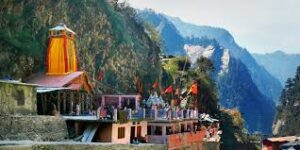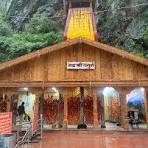Yamunotri Temple
The Yamunotri Temple is situated in the Western region of Garhwal Himalayas at an altitude of 3,291 m in Uttarkashi district Uttarakhand. It’s just 129 km from Uttarkashi , the main district headquarters. The temple is dedicated to Goddess Yamuna, and has q black marble idol of the goddess .
The Yamunotri temple is a day’s journey from Uttarakhand’s main towns , Uttarkashi ,Rishikesh, Haridwar or Dehradun.The actual temple is only accessible by a 13km trek from the town of Hanuman Chatti and a 6km walkb from Janki Chatti, horses or palanquins are available for rent. The hike from Hanuman Chatti to Yamunotri takes in a view of number of waterfalls.
Three are two traking routes from Hanuman Chatti to Yamunotri , the one along the right bank proceeds via the Markandeya Tirth , where the sage Markadeya wrote the Markandeya Purana. The other route which lies on the left bank of the river goes via Kharsali , from where Yamunotri is a five or six hours climb.
The interior of the temple consists of a Garbh Grih and Mandap where devotees gather for darshan and prayer. Garbh Grih contains idol of goddess Yamuna made with Black marble and decorated with garlands.
Yamunotri Temple is one of the most revered Hindu pilgrimage sites in India, dedicated to Goddess Yamuna. Located in the Uttarkashi district of Uttarakhand, this temple is a significant part of the Chota Char Dham Yatra, which also includes Gangotri, Kedarnath, and Badrinath.
Nestled in the lap of the majestic Himalayas, the temple stands at an altitude of about 3,293 meters (10,804 feet) above sea level. Pilgrims from all over India and the world visit this sacred shrine to seek blessings from the goddess and experience the divine beauty of the region.

Yamunotri Temple:History
Yamunotri temple has a shrine dedicated to the goddess. There is also an 18th century temple at Gangotri, which was damaged and re-innovated in the 19th century . The temple has been destroyed twice by snow and floods before being rebuilt.
It is located on the backdrop of Bandarpunch. Temple is part of the revered Char Dham pilgrim circuit. Yamunotri Temple constructed by King of Tehri , Naresh Sudarshan Shan in 1839. The temple opens on Akshaya Tritiya and closes on Yama Dwitiya ( second day after Diwali ) for the winter.
A little ahead is at an actual source of the river Yamuna, which is at an altitude of about 4,421 meters appr. Two hot springs are also present at Yamunotri, offering relief to tired hikers at a height of 3,292 m. Surya kund has boiling hot water , while Gauri kund has tepid water suitable for bathing.
Historical and Mythological Significance
Yamunotri Temple holds great religious and mythological importance in Hinduism. According to legend, Goddess Yamuna is the daughter of Surya, the Sun God, and the twin sister of Yama, the God of Death. It is believed that taking a dip in the holy waters of the Yamuna River at Yamunotri protects devotees from untimely death and purifies their souls.
Another mythological story states that the temple site was the meditation spot of Sage Asit Muni, who spent his life in deep penance in the Himalayas. He used to bathe in both the Ganga and Yamuna rivers, but in his old age, he found it difficult to travel to the Ganges. As a result, a stream of the Yamuna emerged near his hermitage, allowing him to continue his holy rituals.
Architectural Features
The Yamunotri Temple was originally built by Maharaja Pratap Shah of Tehri Garhwal in the 19th century. Over the years, the temple has undergone several renovations due to damage caused by natural calamities. The structure of the temple is simple yet elegant, constructed using stone and wood with a striking black marble idol of Goddess Yamuna inside.
The temple’s surroundings are adorned with snow-capped peaks, lush greenery, and gushing streams, creating a breathtaking spiritual atmosphere.
The Sacred Yamuna River
The Yamunotri Temple is situated near the origin of the Yamuna River, which is considered the second holiest river in India after the Ganges. The actual source of the river is the Yamunotri Glacier, located about 6 kilometers further up the mountains at an altitude of 6,315 meters. However, due to the difficult terrain, most devotees worship at the temple instead of traveling to the glacier.
The Yamuna River plays a crucial role in Hindu beliefs, as it is regarded as a life-giving force. Many devotees believe that drinking its water or taking a dip in the river cleanses them of sins and ensures a peaceful afterlife.
Hot Springs and Religious Rituals
One of the unique features of Yamunotri Temple is the presence of hot water springs near the shrine. The most famous spring is the Surya Kund, named after the Sun God. The water in this spring is so hot that devotees cook rice and potatoes in cloth bags and offer them to the goddess as prasad (holy offering). The cooked rice is later taken home as a sacred blessing.
Another important spring is the Divya Shila, a rock pillar near the temple, which is worshipped before entering the main shrine. Pilgrims perform rituals and prayers at this spot to pay respect to the divine energy of the place.
Pilgrimage Journey to Yamunotri
The journey to Yamunotri Temple is both challenging and spiritually uplifting. The nearest accessible town is Hanuman Chatti, from where the actual trek begins. Pilgrims travel to Janki Chatti, which serves as the base camp for the temple. From there, a 6-kilometer trek leads to the temple.
The trekking route passes through dense forests, steep mountain paths, and scenic landscapes. For those who find it difficult to walk, ponies and palanquins are available. The journey is considered a test of faith, and devotees endure the hardships with devotion and enthusiasm.
Best Time to Visit
The Yamunotri Temple remains open for visitors from May to October. It is closed during winter due to heavy snowfall, and the idol of Goddess Yamuna is shifted to Kharsali, a nearby village, where it is worshipped during the colder months.
The ideal time to visit is between May and June or September and October, when the weather is pleasant and the trekking conditions are favorable. During the monsoon season (July-August), landslides and heavy rainfall can make travel dangerous.
Festivals and Celebrations
Several Hindu festivals are celebrated at Yamunotri Temple with great devotion. The most important among them is Akshaya Tritiya, which marks the opening of the temple in summer. Thousands of devotees participate in religious ceremonies, chanting hymns and offering prayers.
Another significant occasion is Diwali, when the temple is closed for winter. The idol of Goddess Yamuna is carried down to Kharsali in a grand procession, accompanied by devotional songs and rituals.
Spiritual Importance and Beliefs
The Yamunotri Temple is not just a place of worship but a center of faith and devotion. It is believed that those who undertake the Char Dham Yatra, which includes Yamunotri, attain spiritual salvation. The journey represents purification, enlightenment, and a closer connection with the divine.
Many pilgrims visit the temple to seek blessings for a prosperous and healthy life. People suffering from ailments or misfortunes also come here with the hope of healing through the divine grace of Goddess Yamuna.
Conclusion
Yamunotri Temple is a symbol of unwavering faith and divine beauty. Its serene environment, rich mythology, and spiritual significance make it one of the most cherished pilgrimage destinations in India. The journey to Yamunotri is not just a physical adventure but a soulful experience that leaves a lasting impression on devotees. Whether for religious purposes or to witness the breathtaking beauty of the Himalayas, a visit to Yamunotri Temple is a truly unforgettable experience.


